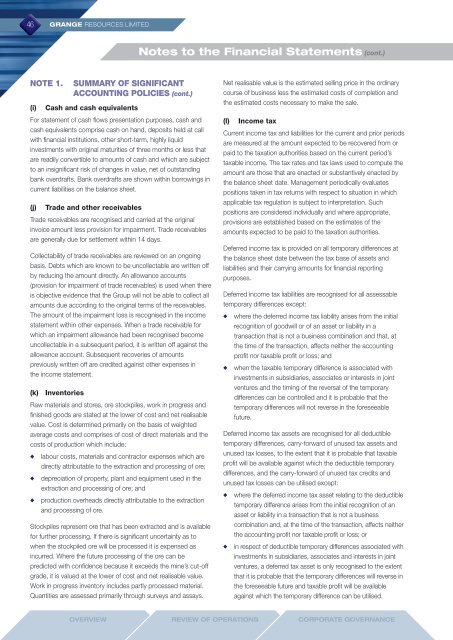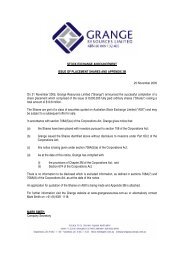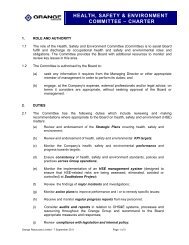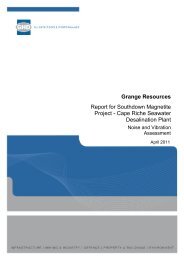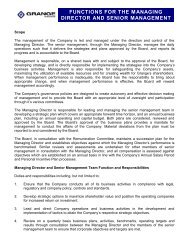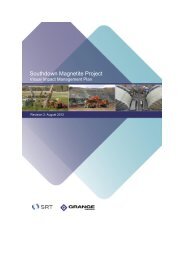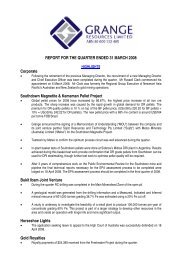2010 Annual Report - Grange Resources
2010 Annual Report - Grange Resources
2010 Annual Report - Grange Resources
Create successful ePaper yourself
Turn your PDF publications into a flip-book with our unique Google optimized e-Paper software.
46 GRANGE RESOURCES LIMITED<br />
Notes to the Financial Statements (cont.)<br />
NOTE 1.<br />
(i)<br />
SUMMARY OF SIGNIFICANT<br />
aCCOUNTING POLICIES (cont.)<br />
Cash and cash equivalents<br />
For statement of cash flows presentation purposes, cash and<br />
cash equivalents comprise cash on hand, deposits held at call<br />
with financial institutions, other short-term, highly liquid<br />
investments with original maturities of three months or less that<br />
are readily convertible to amounts of cash and which are subject<br />
to an insignificant risk of changes in value, net of outstanding<br />
bank overdrafts. Bank overdrafts are shown within borrowings in<br />
current liabilities on the balance sheet.<br />
(j) Trade and other receivables<br />
Trade receivables are recognised and carried at the original<br />
invoice amount less provision for impairment. Trade receivables<br />
are generally due for settlement within 14 days.<br />
Collectability of trade receivables are reviewed on an ongoing<br />
basis. Debts which are known to be uncollectable are written off<br />
by reducing the amount directly. An allowance accounts<br />
(provision for impairment of trade receivables) is used when there<br />
is objective evidence that the Group will not be able to collect all<br />
amounts due according to the original terms of the receivables.<br />
The amount of the impairment loss is recognised in the income<br />
statement within other expenses. When a trade receivable for<br />
which an impairment allowance had been recognised become<br />
uncollectable in a subsequent period, it is written off against the<br />
allowance account. Subsequent recoveries of amounts<br />
previously written off are credited against other expenses in<br />
the income statement.<br />
(k) Inventories<br />
Raw materials and stores, ore stockpiles, work in progress and<br />
finished goods are stated at the lower of cost and net realisable<br />
value. Cost is determined primarily on the basis of weighted<br />
average costs and comprises of cost of direct materials and the<br />
costs of production which include:<br />
◆ ◆ labour costs, materials and contractor expenses which are<br />
directly attributable to the extraction and processing of ore;<br />
◆ ◆ depreciation of property, plant and equipment used in the<br />
extraction and processing of ore; and<br />
◆ ◆ production overheads directly attributable to the extraction<br />
and processing of ore.<br />
Stockpiles represent ore that has been extracted and is available<br />
for further processing. If there is significant uncertainty as to<br />
when the stockpiled ore will be processed it is expensed as<br />
incurred. Where the future processing of the ore can be<br />
predicted with confidence because it exceeds the mine’s cut-off<br />
grade, it is valued at the lower of cost and net realisable value.<br />
Work in progress inventory includes partly processed material.<br />
Quantities are assessed primarily through surveys and assays.<br />
Net realisable value is the estimated selling price in the ordinary<br />
course of business less the estimated costs of completion and<br />
the estimated costs necessary to make the sale.<br />
(l) Income tax<br />
Current income tax and liabilities for the current and prior periods<br />
are measured at the amount expected to be recovered from or<br />
paid to the taxation authorities based on the current period’s<br />
taxable income. The tax rates and tax laws used to compute the<br />
amount are those that are enacted or substantively enacted by<br />
the balance sheet date. Management periodically evaluates<br />
positions taken in tax returns with respect to situation in which<br />
applicable tax regulation is subject to interpretation. Such<br />
positions are considered individually and where appropriate,<br />
provisions are established based on the estimates of the<br />
amounts expected to be paid to the taxation authorities.<br />
Deferred income tax is provided on all temporary differences at<br />
the balance sheet date between the tax base of assets and<br />
liabilities and their carrying amounts for financial reporting<br />
purposes.<br />
Deferred income tax liabilities are recognised for all assessable<br />
temporary differences except:<br />
◆◆<br />
where the deferred income tax liability arises from the initial<br />
recognition of goodwill or of an asset or liability in a<br />
transaction that is not a business combination and that, at<br />
the time of the transaction, affects neither the accounting<br />
profit nor taxable profit or loss; and<br />
◆ ◆ when the taxable temporary difference is associated with<br />
investments in subsidiaries, associates or interests in joint<br />
ventures and the timing of the reversal of the temporary<br />
differences can be controlled and it is probable that the<br />
temporary differences will not reverse in the foreseeable<br />
future.<br />
Deferred income tax assets are recognised for all deductible<br />
temporary differences, carry-forward of unused tax assets and<br />
unused tax losses, to the extent that it is probable that taxable<br />
profit will be available against which the deductible temporary<br />
differences, and the carry-forward of unused tax credits and<br />
unused tax losses can be utilised except:<br />
◆◆<br />
◆◆<br />
where the deferred income tax asset relating to the deductible<br />
temporary difference arises from the initial recognition of an<br />
asset or liability in a transaction that is not a business<br />
combination and, at the time of the transaction, affects neither<br />
the accounting profit nor taxable profit or loss; or<br />
in respect of deductible temporary differences associated with<br />
investments in subsidiaries, associates and interests in joint<br />
ventures, a deferred tax asset is only recognised to the extent<br />
that it is probable that the temporary differences will reverse in<br />
the foreseeable future and taxable profit will be available<br />
against which the temporary difference can be utilised.<br />
Overview<br />
Review Of Operations<br />
Corporate Governance


